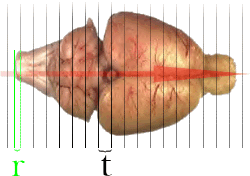Preferential Sectioning
The appearance of biological tissue under the microscope always depends on the plane of section (for instance, consider the difference between cross-sections and longitudinal sections through the spinal cord). Accordingly, most biological tissue is not isotropic. This anisotropy (non-isotropic, i.e., having a preferential direction), however, can influence the results of quantitative histological analyses (for instance, in a cross-section through the spinal cord more nerve fiber transections [i.e., cross-sectional fiber profiles] are found than in a longitudinal section). In the earlier days of design-based stereology, this problem was addressed by introducing isotropy in the planes of section, i.e., by preparing “isotropic uniform random” sections or “vertical” sections. These methods, however, could rarely be successfully introduced in the field of neuroscience. Rather the issue of anisotropy in biological tissue was re-addressed by introducing isotropy in a novel set of design-based stereological methods. Now many design-based stereological methods can be successfully applied on thick tissue sections with any plane of section.
SRS Preferential Sections
The simplest form of random section sample is obtained by using a series of preferentially cut sections obtained with a randomized start. Preferential sections, sometimes called arbitrary sections, means you get to section the tissue as you like it, for instance in the coronal, sagittal, or horizontal plane, or anything in-between. If the nature of the probe does not call for isotropy, such as with the Cavalieri probe for volume and the Optical Fractionator probe for number, or if the probe itself can be made isotropic, such as for the Spaceballs probe for length and the Isotropic Fakir probe for surface, then you can use preferential sections.
SRS sections are related to each other as well. The sections are taken parallel to each other. What makes an SRS section a random section is that the starting position for the sectioning is randomly chosen. This is the sole randomness of an SRS section.
SRS sections are not applicable to all stereological estimators. The requirements of an estimator should be determined first. SRS sections may not be appropriate for local estimators such as the nucleator, or planar rotator. Nor are these sections appropriate for estimation of length or surface area when using cycloid-based probes.

Figure 1 shows a rat brain that has been cut into slabs along a preferential direction. The red arrow illustrates the chosen axis. Each slab is cut to a thickness of t. The randomness is not the orientation, which has been chosen. On the left side of the rat brain is an offset r. This is a randomly chosen amount of the thickness t.
The random amount r does not have to be calculated using a random number table or a computer program to generate a random number. If the tissue is embedded in a block and slabbed and the position of the slabs is not known, then the slabs are SRS sections. However, if the slabbing is done knowing that the first cut is close to the start of the tissue, then these slabs are not truly random.
Preferentially oriented sections, slices, or slabs that do not have a random starting point are called preferential sections, slices, and slabs. The randomness requirements for SRS sections are the simplest requirements. Should there be some doubt as to the randomness of the material used in a study it is appropriate to mention this in any publication reporting stereological results.
____________________________________________________________________

Sponsored by MBF Bioscience
developers of Stereo Investigator, the world’s most cited stereology system
